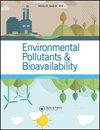Spatial distribution of total halogenated organic compounds (TX), adsorbable organic halogens (AOX), and heavy metals in wetland soil irrigated with pulp and paper wastewater
Q3 Chemical Engineering
引用次数: 13
Abstract
Abstract Long-term irrigation using wastewater from paper industry may cause seriously problems to the receiving soil. This work surveyed and monitored the soil quality of a wastewater irrigation wetland system in Yancheng City, Jiangsu Province in China in 2014 and 2015. Τhe wetland soil showed different soil properties and TX, AOX, heavy metal contents after long-term wastewater irrigation. Long-term irrigation also accumulated the heavy metals such as Cu, Cd, Zn, and Pb in the wetland soil. Compared to the control, TX in the irrigated soil increased by 47.7–69.8% (2014) and 61.5–83.1% (2015). AOX varied in concentration from 1.7 to 55.0 mg kg−1 (2014) and 11.0 to 53.0 mg kg−1 (2015). The long-term irrigation of wastewater to wetland systems caused the accumulations of heavy metals, TX, and AOX in the soil and the levels of accumulations were related to several factors including soil properties, wastewater quality, and irrigation time.纸浆造纸废水灌溉湿地土壤中总卤化有机化合物(TX)、可吸附有机卤素(AOX)和重金属的空间分布
摘要长期利用造纸废水进行灌溉,会对受水土壤造成严重的污染。本研究于2014年和2015年对江苏省盐城市污水灌溉湿地系统土壤质量进行了调查和监测。Τhe湿地土壤经长期废水灌溉后呈现出不同的土壤性质和TX、AOX、重金属含量。长期灌溉还积累了湿地土壤中的Cu、Cd、Zn、Pb等重金属。与对照相比,灌溉土壤TX分别增加了47.7 ~ 69.8%(2014年)和61.5 ~ 83.1%(2015年)。AOX的浓度变化范围为1.7 - 55.0 mg kg - 1(2014年)和11.0 - 53.0 mg kg - 1(2015年)。长期向湿地系统灌溉废水导致土壤中重金属、TX和AOX的积累,其积累水平与土壤性质、废水水质和灌溉时间等因素有关。
本文章由计算机程序翻译,如有差异,请以英文原文为准。
求助全文
约1分钟内获得全文
求助全文
来源期刊
CiteScore
1.62
自引率
0.00%
发文量
0
审稿时长
1 months
期刊介绍:
Chemical Speciation & Bioavailability ( CS&B) is a scholarly, peer-reviewed forum for insights on the chemical aspects of occurrence, distribution, transport, transformation, transfer, fate, and effects of substances in the environment and biota, and their impacts on the uptake of the substances by living organisms. Substances of interests include both beneficial and toxic ones, especially nutrients, heavy metals, persistent organic pollutants, and emerging contaminants, such as engineered nanomaterials, as well as pharmaceuticals and personal-care products as pollutants. It is the aim of this Journal to develop an international community of experienced colleagues to promote the research, discussion, review, and spread of information on chemical speciation and bioavailability, which is a topic of interest to researchers in many disciplines, including environmental, chemical, biological, food, medical, toxicology, and health sciences.
Key themes in the scope of the Journal include, but are not limited to, the following “6Ms”:
Methods for speciation analysis and the evaluation of bioavailability, especially the development, validation, and application of novel methods and techniques.
Media that sustain the processes of release, distribution, transformation, and transfer of chemical speciation; of particular interest are emerging contaminants, such as engineered nanomaterials, pharmaceuticals, and personal-care products.
Mobility of substance species in environment and biota, either spatially or temporally.
Matters that influence the chemical speciation and bioavailability, mainly environmentally relevant conditions.
Mechanisms that govern the transport, transformation, transfer, and fate of chemical speciation in the environment, and the biouptake of substances.
Models for the simulation of chemical speciation and bioavailability, and for the prediction of toxicity.
Chemical Speciation & Bioavailability is a fully open access journal. This means all submitted articles will, if accepted, be available for anyone to read, anywhere, at any time. immediately on publication. There are no charges for submission to this journal.

 求助内容:
求助内容: 应助结果提醒方式:
应助结果提醒方式:


